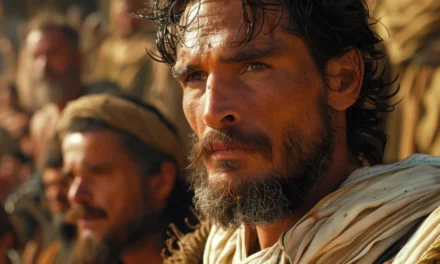
Interacting with the Divine

In our world filled with various gods and objects of worship, the God of the Bible stands apart as unique and extraordinary. The distinction becomes evident as we open up the Scriptures, witnessing how this omnipotent Creator interacts with His creation. While many cultures revere inanimate objects, the God of All Creation cannot be confined to such limitations. However, intriguingly, God often employs objects to communicate His nature and purpose. In the pages of the Bible, particularly in 1 Samuel 5, we find an illuminating example of this phenomenon—the Ark of the Covenant.
The Symbolism of the Ark
Imagine a gold-plated box, intricately adorned with scroll work and angelic figures with outstretched wings—an awe-inspiring masterpiece. This is the Ark of the Covenant. Though it held immense material value, its significance exceeded its splendor. The Ark was more than an object; it was a place of encounter with the Almighty. The high priest would enter, offering animal sacrifices and sprinkling blood upon the lid. This act bridged the gap between humanity’s sinfulness and God’s holiness.
In the ancient world where idolatry and rituals prevailed, the Ark’s worship method seemed familiar. Surrounding cultures also had elaborate objects of devotion, accompanied by animal and even human sacrifices. Yet, a pivotal contrast emerged—the God of All Creation met with His people to address sin through this object.
The Message of the Ark
Central to understanding the Ark’s purpose is recognizing that it wasn’t the source of power; rather, it was a conduit for God’s message of reconciliation. When Adam and Eve’s disobedience introduced sin, God killed an animal to provide them clothing. This act signified the shedding of blood for covering and acceptance. The Ark echoed this message, pointing toward God’s ultimate plan for redemption.
Crucially, the Ark represented but didn’t replace its divine originator. It was a place of worship, not an entity to be worshipped. This blending of symbolism and reality is strikingly evident in the account where the Philistines captured the Ark—a defining moment in the Ark’s narrative.
The Ark and Its Unconventional Impact
The Ark’s story takes an unexpected twist when Israel’s enemies, the Philistines, captured it. Placing it in the temple of their god, the half-man half-fish, deity they called Dagon. They intended to exhibit their conquest among their collection of gods, showcasing their superiority. Yet, the transcendent God’s response defied their expectations. Each morning, Dagon’s statue lay prostrate before the Ark. Even after propping it up, the next day revealed an even more extraordinary sight—the statue’s head and hands severed. This series of events testified to the unmistakable presence of the God of All Creation. It was a testimony that the God they attempted to control was uncontainable.
The Ultimate Interaction: God Incarnate
While the Ark showcased God’s unique interaction in the Old Testament, His most profound intervention was the incarnation of Jesus Christ. The God who transcended creation became part of it—a mystery beyond comprehension, driven solely by love. The well-known verse, John 3:16, encapsulates this truth: “For God so loved the world, that He gave His only begotten Son…”
The Incarnation shattered barriers. It wasn’t a mere toppling of stone statues, but a demolishing of the age-old division caused by sin. The cross and the sacrificial blood of Jesus became the means of reconciliation. Now, we can boldly approach God, because the debt for our sins have been paid by Christ’s blood. This is a monumental shift from the animal skins used in Eden to cover Adam and Eve’s shame or the blood of animals sprinkled on the Ark. Christ’s blood doesn’t just cover us, it removes the barrier of sin in our lives.
Applying the Truths of the Ark
The lessons from the Ark of the Covenant continue to hold relevance today. As believers, we can draw inspiration and practical applications from this ancient narrative. Let’s explore how we can incorporate these truths into our lives:
- The Object of Worship: Just as the Ark was a place of worship, let’s remember that our worship should be directed solely to God. Matthew 4:10 reminds us, “You shall worship the Lord your God and serve Him only.”
- The Reality of Reconciliation: The Ark symbolized God’s desire to reconcile with humanity. Through Christ, we experience complete reconciliation. 2 Corinthians 5:18-19 affirms, “Now all these things are from God, who reconciled us to Himself through Christ.”
- The Power of God’s Presence: Just as the Ark brought awe and reverence, acknowledging God’s presence in our lives should evoke similar awe. 1 Corinthians 3:16 assures us, “Do you not know that you are a temple of God and that the Spirit of God dwells in you?”
- The Triumph Over Idolatry: The Philistines’ failed attempts to control the Ark teach us that God cannot be manipulated. We should strive to remove idols from our lives, remembering 1 John 5:21, “Little children, guard yourselves from idols.”
- Embracing the Incarnation: Reflect on the immense love God displayed by sending His Son. Embrace the truth of 1 Timothy 3:16, “By common confession, great is the mystery of godliness: He who was revealed in the flesh, was vindicated in the Spirit…”
- Bold Access through Christ: The Ark’s significance in covering shame finds its fulfillment in Christ’s sacrifice. Hebrews 4:16 encourages us, “Therefore let us draw near with confidence to the throne of grace, so that we may receive mercy and find grace to help in time of need.”
The Remarkable Object
The Ark of the Covenant stands as a symbol of God’s unique interaction with humanity, bridging the gap between divinity and the sinful person. Through this remarkable object, God communicated His desire for reconciliation, foreshadowing the ultimate act of love—the incarnation of Jesus Christ. Just as the Ark’s purpose extended beyond its physical form, our lives can transcend the mundane when we apply these lessons.
As we journey through life, let’s emulate the purity of worship demonstrated at the Ark. Let’s grasp the reality of reconciliation through Christ’s sacrifice. Let’s be conscious of God’s ever-present Spirit and forsake idols that vie for our devotion. Above all, let the wonder of the Incarnation wash over you, recognizing that through Christ, we are fully known and fully loved. By embracing these truths, we can live boldly, knowing we stand accepted and unashamed in the presence of the God of All Creation.










Recent Comments